Experimental and Numerical Evaluation of Solar Receiver Heat Losses of a Commercial 9 MWe Linear Fresnel Power Plant
Abstract
:1. Introduction
2. eLLO Solar Field Presentation
- A steel absorber tube (1.4301 steel) with a selective coating to enhance the thermo-optical properties;
- A secondary reflector type compound parabolic concentrator (CPC) made of aluminum, allowing for the reflection of the part of the radiation that does not directly impact the absorber tube;
- A protective enclosure made of galvanized steel and a specific protective glass to limit convection losses.
3. Materials and Methods
3.1. Calculation Methods to Evaluate Heat Losses
3.2. Low and High-Temperature Protocols
- To homogenize the temperatures of the fluid between the solar field and the separator tank and thus limit the water hammer during the restart in summer;
- To prevent the risk of freezing in winter.
3.3. Temperature Evolution of the Solar Lines
4. Empirical Heat Loss Correlation of the eLLO Receiver
5. Single-Phase Thermohydraulic Model
5.1. Model Hypothesis and Physical Equations
- The glass, the secondary reflector and the protective enclosure are considered as a single body exchanging heat with the absorber tube and the environment. The physical and optical properties of the equivalent protective enclosure are approximated by the average of the properties shown in Table 1.
- The thermal properties of the absorber and the envelope are constant for the considered temperatures.
- The radiation between the absorber tube and the protective enclosure is considered between two concentric semi-infinite tubes.
- The protective enclosure radiates towards a virtual environment at a sky temperature assumed to be 8 °C lower than the ambient temperature [36].
- The velocity of the heat transfer fluid and the temperature are considered uniform over the tube section.
- The thermal diffusion along the tube axis is considered.
- Only the continuity equation is solved to conserve mass as the fluid heats up. Other fluid mechanics considerations are not considered.
- The absorber tube is supported on the guyed masts by a plastic pulley, the conductive heat loss through this support is neglected.
- The heat loss on short pipe runs at the inlet and outlet solar line is neglected.
- The energy conservation equation of the heat transfer fluid contains an accumulation term, an axial diffusion term, an advective term and a convective exchange term with the absorber tube (Equation (6)):
- The energy conservation equation of the absorber tube contains an accumulation term, an axial diffusion term, two convective exchange terms, one with the transfer fluid and the other with the air in the cavity and a radiation term with the protective enclosure:
- The energy conservation equation of the protective enclosure contains an accumulation term, an axial diffusion term, two convection terms, one with the cavity air and the other with the outside and two radiation terms, one with the absorber tube and the other with the sky:
- The convective exchanges are determined using correlations constraining convective heat transfer coefficient. The Nusselt number, Equation (10), reflects the quality of the heat exchange and allows finding the convective exchange coefficients. Each correlation was found in [37], and the condition of application was verified.
- The convective heat transfer within the absorber tube is described by the correlation of Dittus and Boelter. Equation (11) introduces the Dittus and Boelter correlation in the case where the wall temperature is colder than the fluid temperature:
- The convective heat transfer within the cavity is assumed to be a natural convective exchange, described by the Mac Adams correlation (Equation (12)):
- The convective heat transfer between the enclosure and the environment differs according to the wind speed. If the wind speed is less than 1 m/s, then a natural convective heat transfer correlation around a horizontal cylinder is chosen (Equation (13)). Otherwise, the heat transfer coefficient is determined using the Hilpert correlation describing convective heat transfer for flows around a cylinder (Equation (14)). The characteristic length corresponds to the external diameter of the protective enclosure.
- If ,
- In addition,
5.2. Validation and Improvement of the Single-Phase Model
5.3. Numerical Heat Loss Correlation Depending on Wind Speed
6. Conclusions
Author Contributions
Funding
Data Availability Statement
Acknowledgments
Conflicts of Interest
References
- Papadis, E.; Tsatsaronis, G. Challenges in the Decarbonization of the Energy Sector. Energy 2020, 205, 118025. [Google Scholar] [CrossRef]
- Baharoon, D.A.; Rahman, H.A.; Omar, W.Z.W.; Fadhl, S.O. Historical Development of Concentrating Solar Power Technologies to Generate Clean Electricity Efficiently—A Review. Renew. Sustain. Energy Rev. 2015, 41, 996–1027. [Google Scholar] [CrossRef]
- Abbas, R.; Muñoz-Antón, J.; Valdés, M.; Martínez-Val, J.M. High Concentration Linear Fresnel Reflectors. Energy Convers. Manag. 2013, 72, 60–68. [Google Scholar] [CrossRef]
- Montanet, E.; Rodat, S.; Falcoz, Q.; Roget, F. Influence of Topography on the Optical Performances of a Fresnel Linear Asymmetrical Concentrator Array: The Case of the ELLO Solar Power Plant. Energy 2023, 274, 127310. [Google Scholar] [CrossRef]
- Montenon, A.C.; Santos, A.V.; Collares-Pereira, M.; Montagnino, F.M.; Garofalo, R.; Papanicolas, C. Optical Performance Comparison of Two Receiver Configurations for Medium Temperature Linear Fresnel Collectors. Sol. Energy 2022, 240, 225–236. [Google Scholar] [CrossRef]
- Balaji, S.; Reddy, K.S.; Sundararajan, T. Optical Modelling and Performance Analysis of a Solar LFR Receiver System with Parabolic and Involute Secondary Reflectors. Appl. Energy 2016, 179, 1138–1151. [Google Scholar] [CrossRef]
- Mills, D.R. Linear Fresnel Reflector (LFR) Technology. In Concentrating Solar Power Technology; Woodhead Publishing: Cambridge, UK, 2012; pp. 153–196. [Google Scholar]
- Abbas, R.; Martínez-Val, J.M. Analytic Optical Design of Linear Fresnel Collectors with Variable Widths and Shifts of Mirrors. Renew. Energy 2015, 75, 81–92. [Google Scholar] [CrossRef]
- Mathur, S.S.; Kandpal, T.C.; Negi, B.S. Optical Design and Concentration Characteristics of Linear Fresnel Reflector Solar Concentrators—II. Mirror Elements of Equal Width. Energy Convers. Manag. 1991, 31, 221–232. [Google Scholar]
- Jafrancesco, D.; Cardoso, J.P.; Mutuberria, A.; Leonardi, E.; Les, I.; Sansoni, P.; Francini, F.; Fontani, D. Optical Simulation of a Central Receiver System: Comparison of Different Software Tools. Renew. Sustain. Energy Rev. 2018, 94, 792–803. [Google Scholar] [CrossRef]
- Facão, J.; Oliveira, A.C. Numerical Simulation of a Trapezoidal Cavity Receiver for a Linear Fresnel Solar Collector Concentrator. Renew. Energy 2011, 36, 90–96. [Google Scholar] [CrossRef]
- López-Alvarez, J.A.; Larraneta, M.; Silva-Pérez, M.A.; Lillo-Bravo, I. Impact of the Variation of the Receiver Glass Envelope Transmittance as a Function of the Incidence Angle in the Performance of a Linear Fresnel Collector. Renew. Energy 2020, 150, 607–615. [Google Scholar] [CrossRef]
- Beltagy, H. A Secondary Reflector Geometry Optimization of a Fresnel Type Solar Concentrator. Energy Convers. Manag. 2023, 284, 116974. [Google Scholar] [CrossRef]
- Singh, P.L.; Sarviya, R.M.; Bhagoria, J.L. Heat Loss Study of Trapezoidal Cavity Absorbers for Linear Solar Concentrating Collector. Energy Convers. Manag. 2010, 51, 329–337. [Google Scholar] [CrossRef]
- Reynolds, D.J.; Jance, M.J.; Behnia, M.; Morrison, G.L. An Experimental and Computational Study of the Heat Loss Characteristics of a Trapezoidal Cavity Absorber. Sol. Energy 2004, 76, 229–234. [Google Scholar] [CrossRef]
- Ardekani, M.M.; Craig, K.J.; Meyer, J.P. Combined Thermal, Optical and Economic Optimization of a Linear Fresnel Collector. AIP Conf. Proc. 2017, 1850, 040004. [Google Scholar]
- Pye, J.D.; Graham, M.L.; Behnia, M.; Mills, D.R. Modelling of Cavity Receiver Heat Transfer for the Compact Linear Fresnel Reflector. In Paper Knowledge: Toward a Media History of Documents; Duke University Press: Durham, NC, USA, 2014. [Google Scholar]
- Tian, M.; Su, Y.; Zheng, H.; Pei, G.; Li, G.; Riffat, S. A Review on the Recent Research Progress in the Compound Parabolic Concentrator (CPC) for Solar Energy Applications. Renew. Sustain. Energy Rev. 2018, 82, 1272–1296. [Google Scholar] [CrossRef]
- Qiu, Y.; He, Y.L.; Wu, M.; Zheng, Z.J. A Comprehensive Model for Optical and Thermal Characterization of a Linear Fresnel Solar Reflector with a Trapezoidal Cavity Receiver. Renew. Energy 2016, 97, 129–144. [Google Scholar] [CrossRef]
- Abbas, R.; Martínez-Val, J.M. A Comprehensive Optical Characterization of Linear Fresnel Collectors by Means of an Analytic Study. Appl. Energy 2017, 185, 1136–1151. [Google Scholar] [CrossRef]
- Babu, M.; Kuzmin, A.M.; Babu, P.S.; Raj, S.S.; Thiruvasagam, C. Angular Error Correction and Performance Analysis of Linear Fresnel Reflector Solar Concentrating System with Varying Width Mirror Reflector. Mater. Today Proc. 2021, 45, 2348–2353. [Google Scholar] [CrossRef]
- Zhu, G. Development of an Analytical Optical Method for Linear Fresnel Collectors. Sol. Energy 2013, 94, 240–252. [Google Scholar] [CrossRef]
- Chaitanya Prasad, G.S.; Reddy, K.S.; Sundararajan, T. Optimization of Solar Linear Fresnel Reflector System with Secondary Concentrator for Uniform Flux Distribution over Absorber Tube. Sol. Energy 2017, 150, 1–12. [Google Scholar] [CrossRef]
- Beltagy, H.; Semmar, D.; Lehaut, C.; Said, N. Theoretical and Experimental Performance Analysis of a Fresnel Type Solar Concentrator. Renew. Energy 2017, 101, 782–793. [Google Scholar] [CrossRef]
- Montes, M.J.; Barbero, R.; Abbas, R.; Rovira, A. Performance Model and Thermal Comparison of Different Alternatives for the Fresnel Single-Tube Receiver. Appl. Therm. Eng. 2016, 104, 162–175. [Google Scholar] [CrossRef]
- Montenon, A.C.; Tsekouras, P.; Tzivanidis, C.; Bibron, M.; Papanicolas, C. Thermo-Optical Modelling of the Linear Fresnel Collector at the Cyprus Institute. AIP Conf. Proc. 2019, 2126, 100004. [Google Scholar]
- Bittencourt de Sá, A.; Pigozzo Filho, V.C.; Tadrist, L.; Passos, J.C. Experimental Study of a Linear Fresnel Concentrator: A New Procedure for Optical and Heat Losses Characterization. Energy 2021, 232, 121019. [Google Scholar] [CrossRef]
- Lamineries MATTHEY, Acier 1.4301. Available online: https://www.matthey.ch/alliages/aciers-inoxydables (accessed on 3 May 2023).
- Fluke, Emissivity Values of Common Materials. Available online: www.fluke.com (accessed on 3 May 2023).
- Rubin, M. Optical Properties of Soda Lime Silica Glasses. Sol. Energy Mater. 1985, 12, 275–288. [Google Scholar] [CrossRef]
- Novatec Solar. NOVA-1: Turnkey Solar Boiler, Mass Produced in Industrial Precision with Performance Guarantee, Germany; Novatec Solar: Karlsruhe, Germany, 2018. [Google Scholar]
- Kamerling, S.; Vuillerme, V.; Rodat, S. Solar Field Output Temperature Optimization Using a Milp Algorithm and a 0 d Model in the Case of a Hybrid Concentrated Solar Thermal Power Plant for Ship Applications. Energies 2021, 14, 3731. [Google Scholar] [CrossRef]
- Krohne. Catalog: Flow Measurement by Differential Pressure. Available online: https://krohne.com/en/downloads (accessed on 10 October 2023).
- PrismaInstruments. PT100 Avec Transmetteur de Température. Available online: http://www.prisma-instruments.com/instruments-de-mesure-et-regulation/instruments-de-temperature/sonde-avec-transmetteur-de-temperature (accessed on 10 October 2023).
- Fasquelle, T.; Falcoz, Q.; Neveu, P.; Lecat, F.; Flamant, G. A Thermal Model to Predict the Dynamic Performances of Parabolic Trough Lines. Energy 2017, 141, 1187–1203. [Google Scholar] [CrossRef]
- Forristall, R. Heat Transfer Analysis and Modeling of a Parabolic Trough Solar Receiver Implemented in Engineering Equation Solver; National Renewable Energy Laboratory: Golden, CO, USA, 2003.
- Eyglunent, B. Thermique Theorique et Pratique a Usage de l’Ingenieur; Hermes Science Publications: New Castle, PA, USA, 1994. [Google Scholar]
- Mertins, M. Technische und Wirtschaftliche Analyse von Horizontalen Fresnel-Kollektoren. Ph.D. Thesis, University of Karlsruhe, Karlsruhe, Germany, 2009. [Google Scholar]

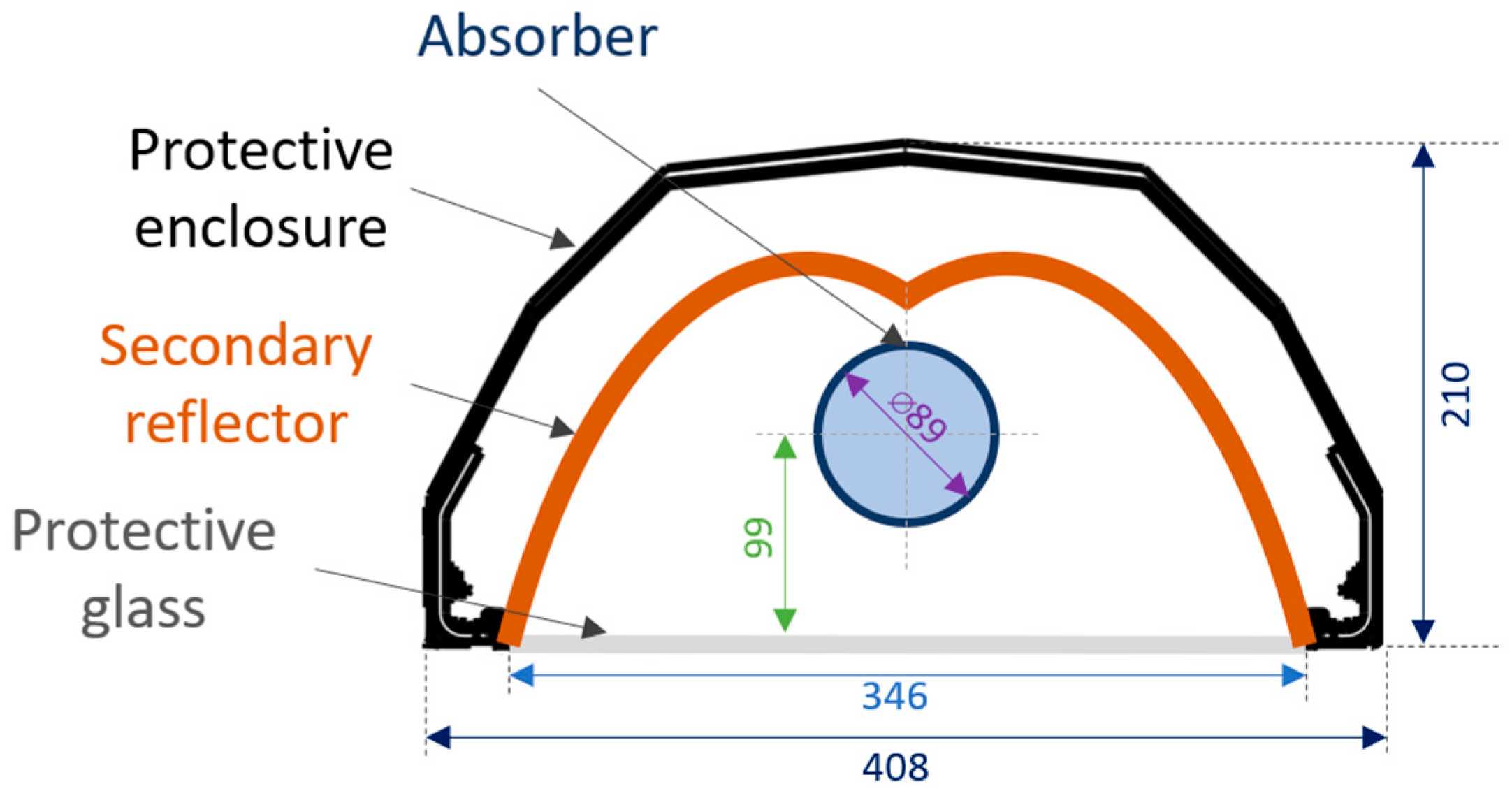
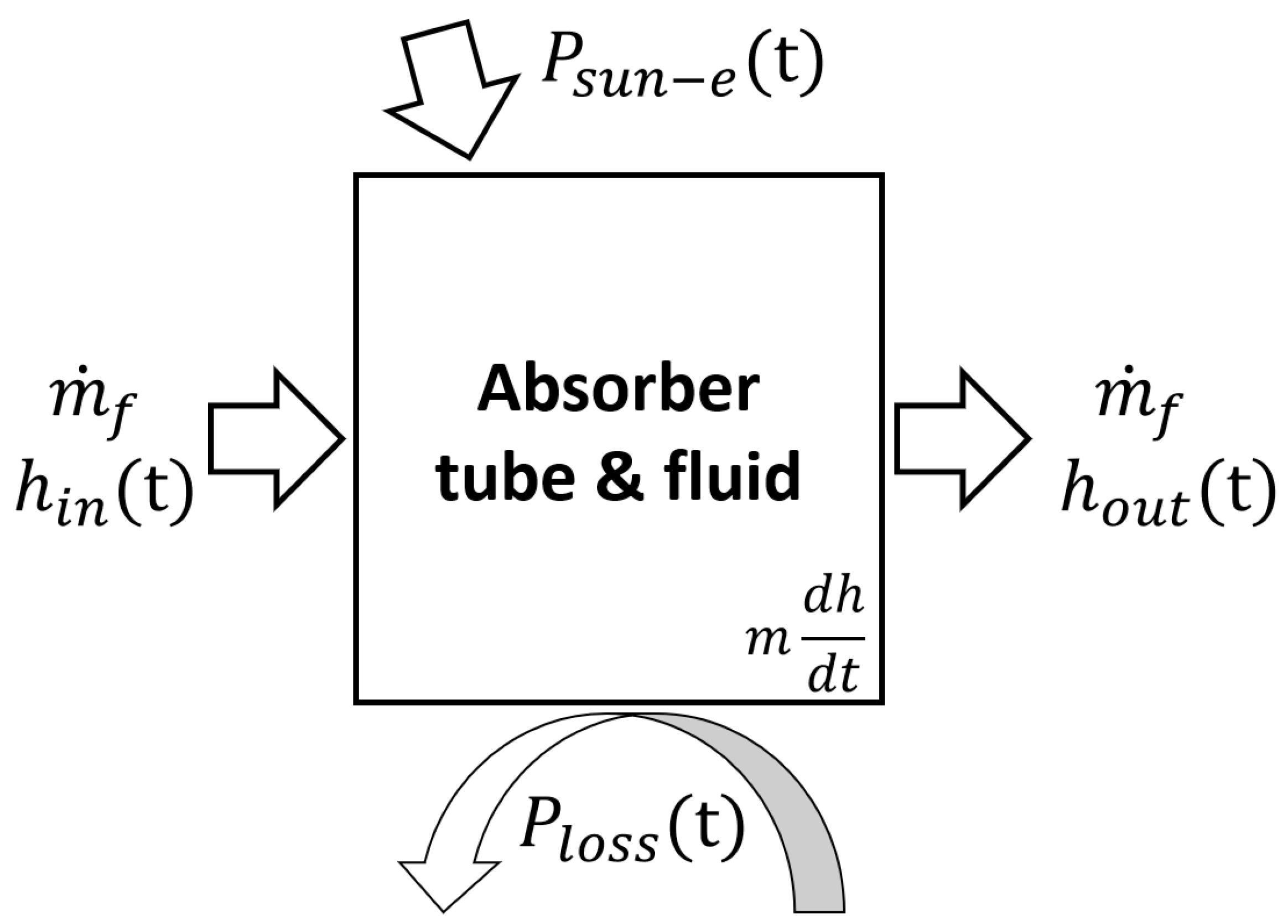
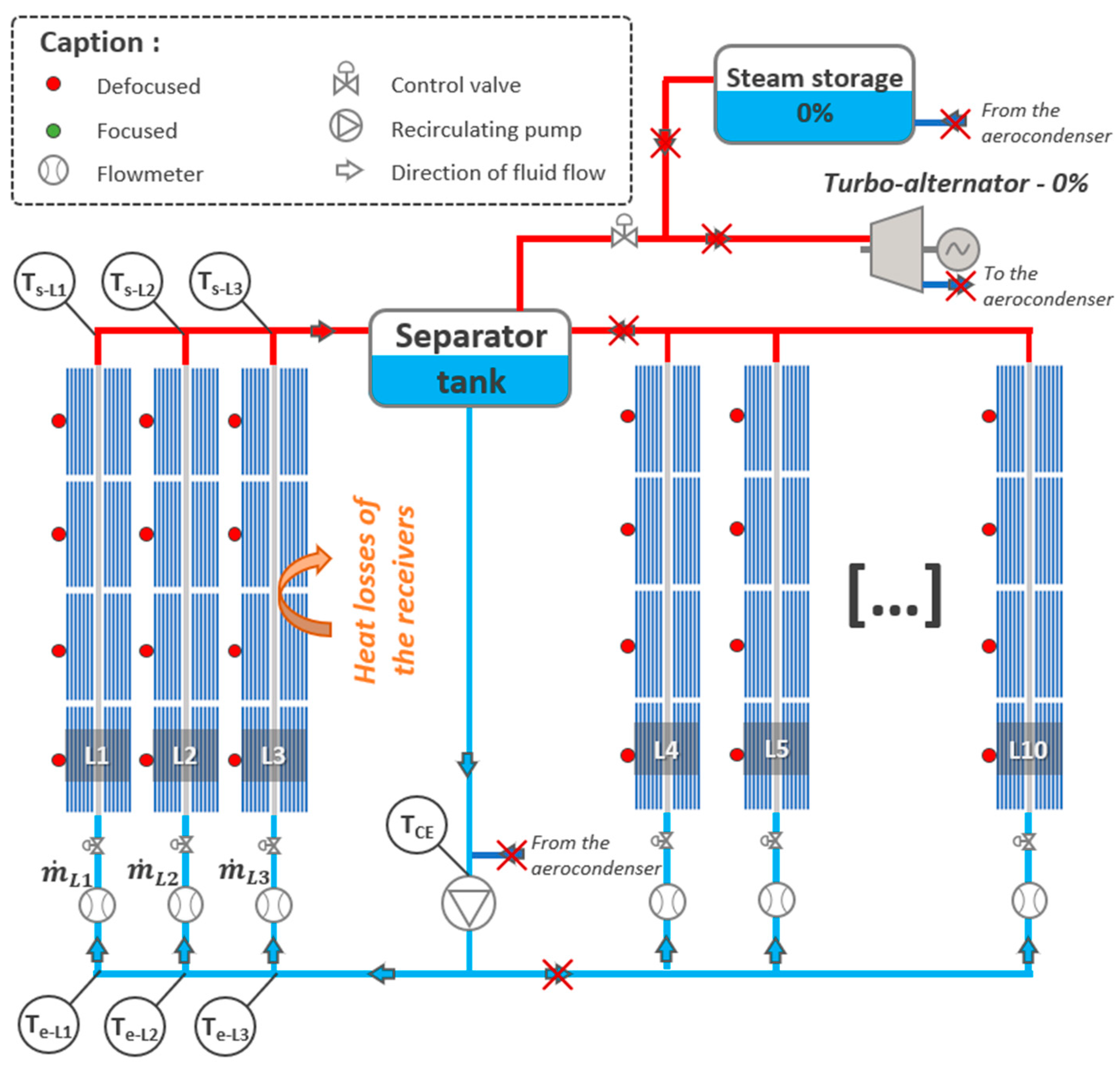
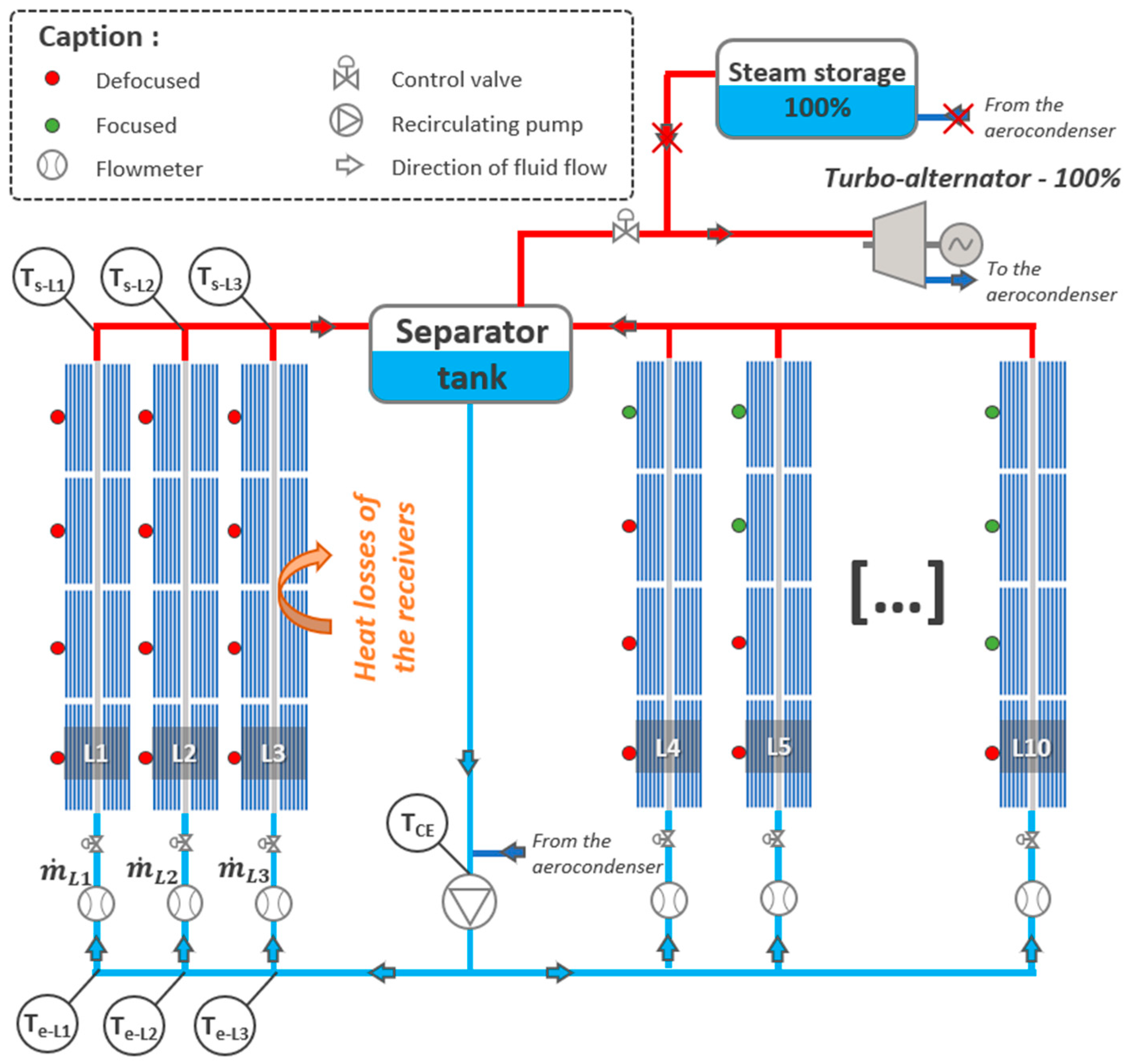
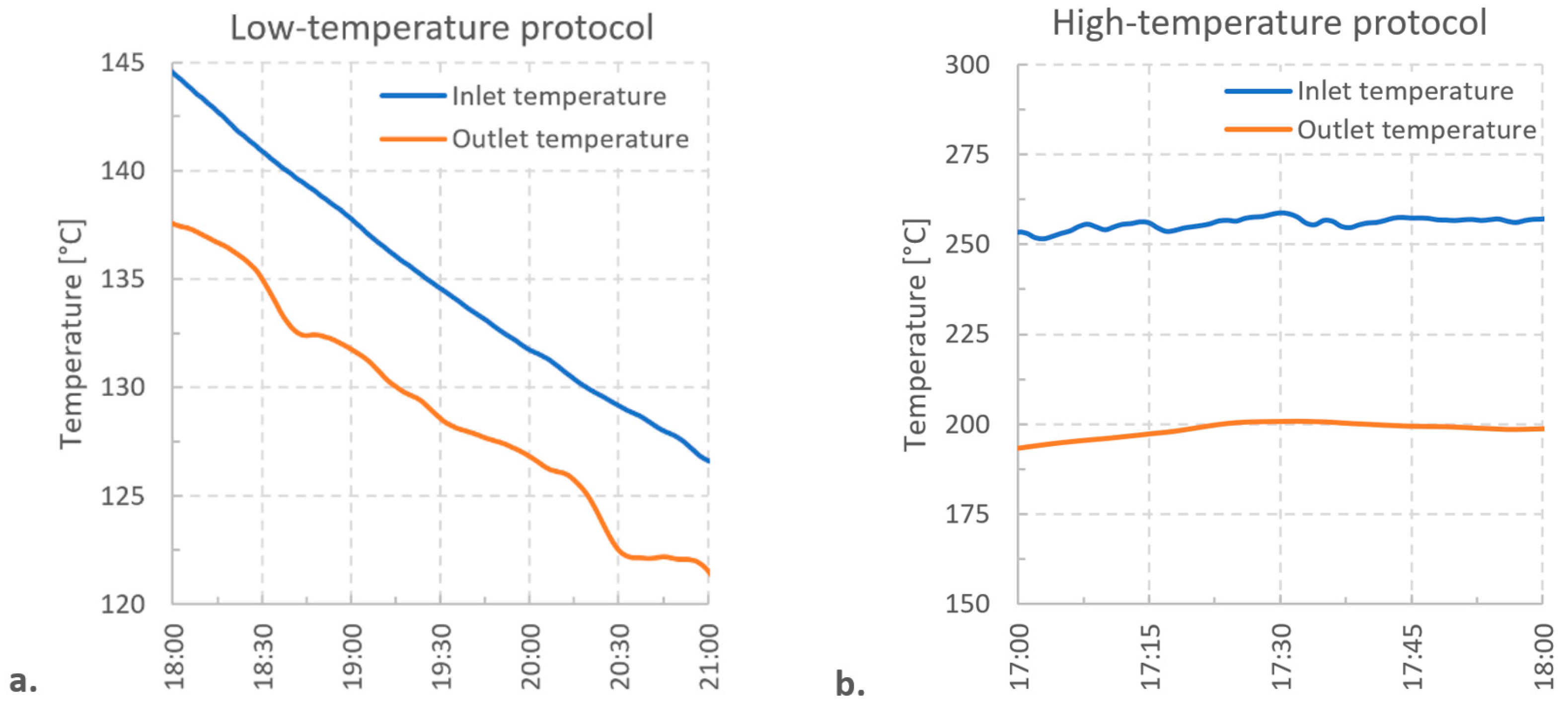
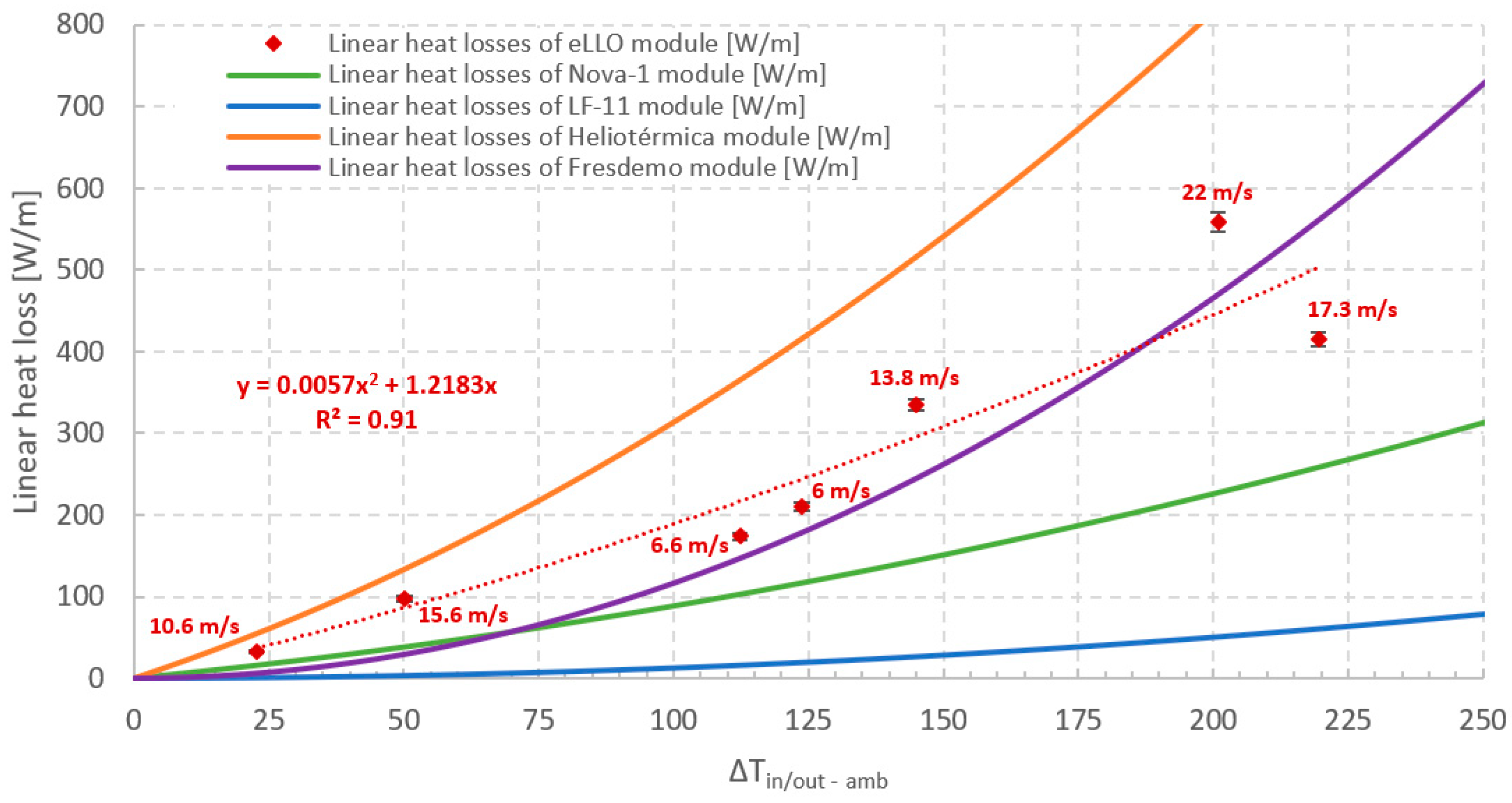
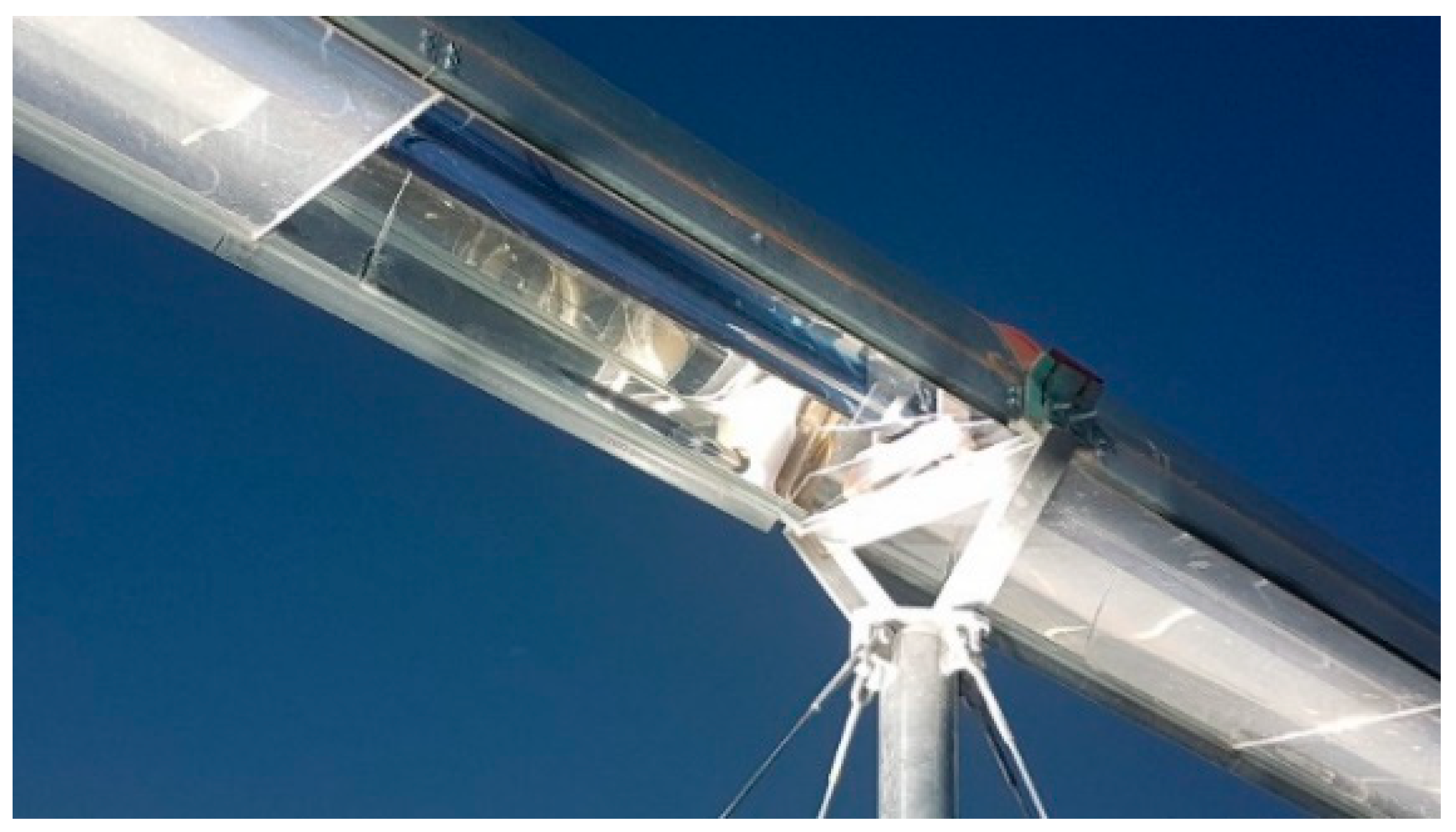
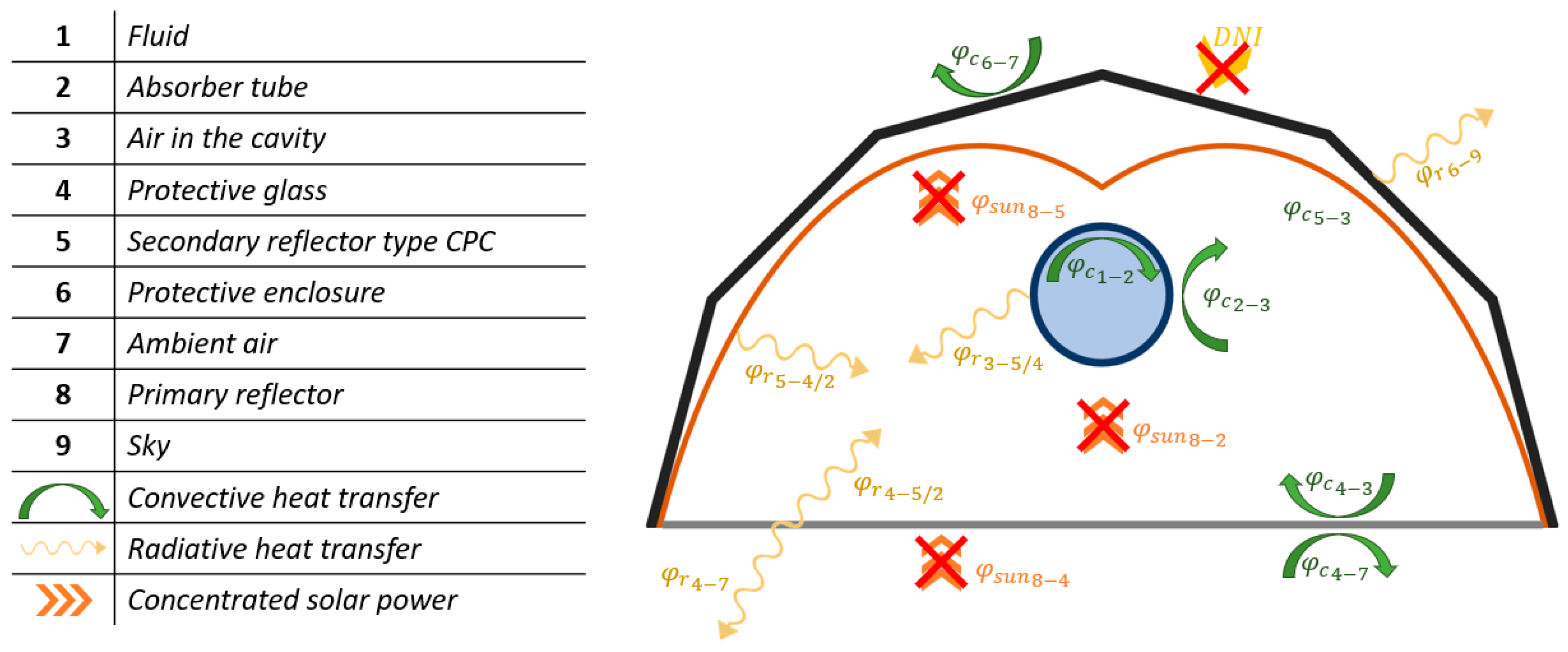
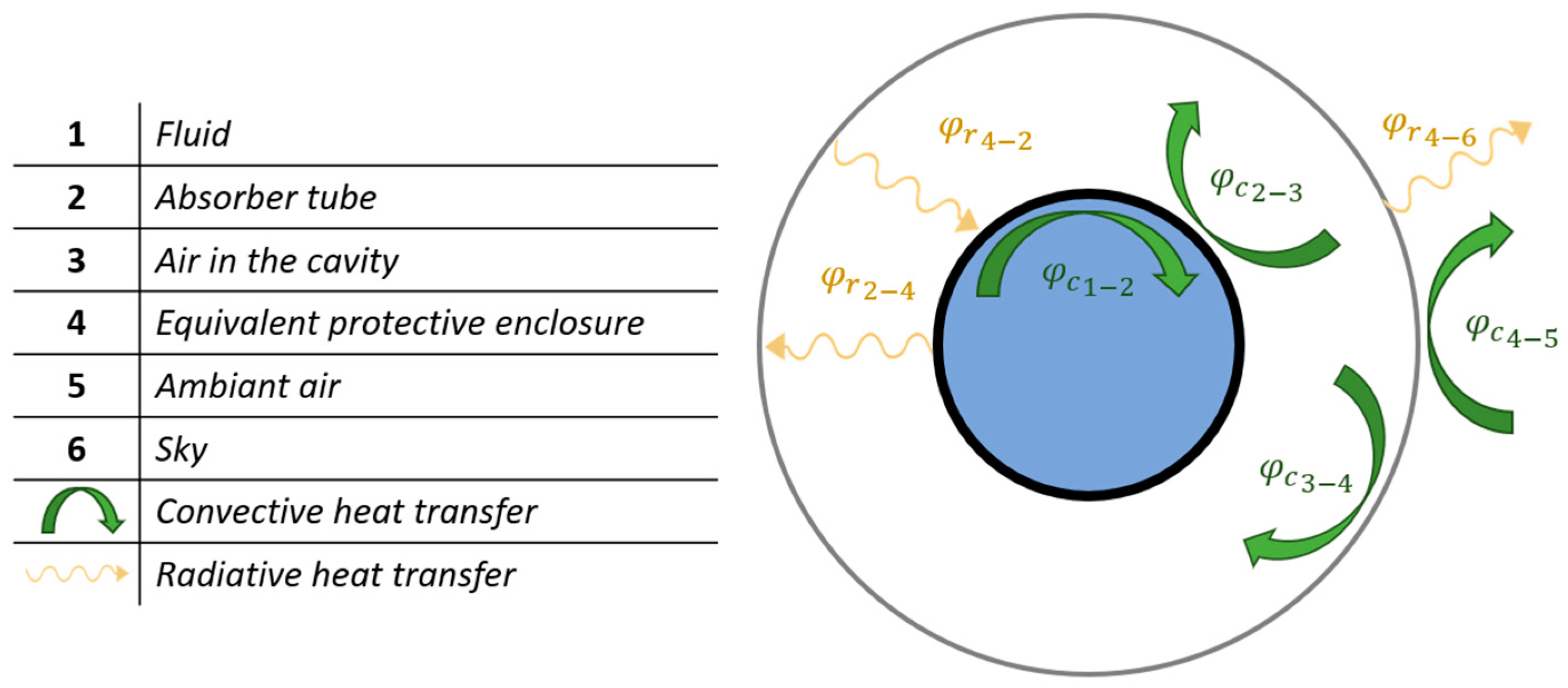

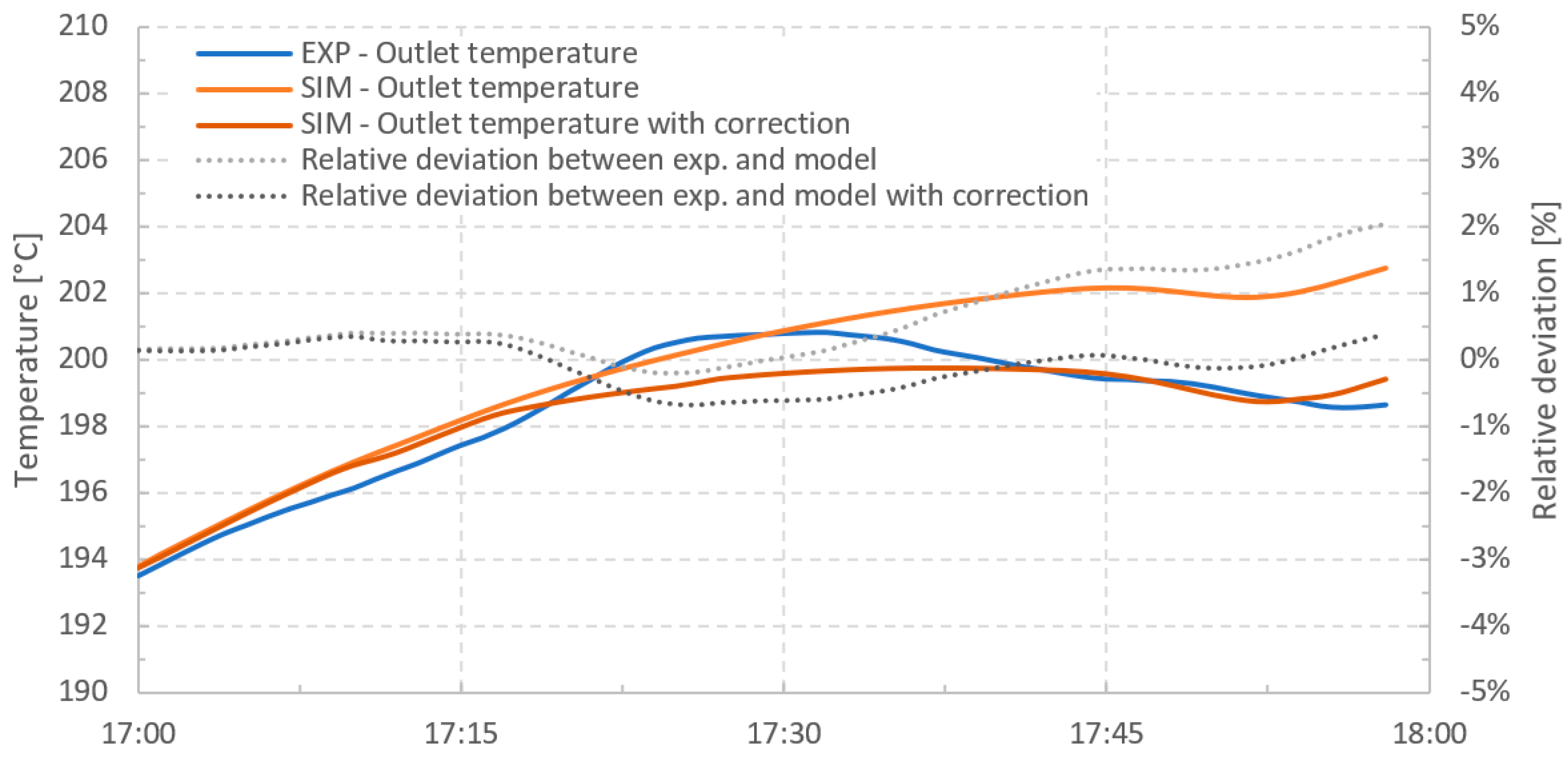
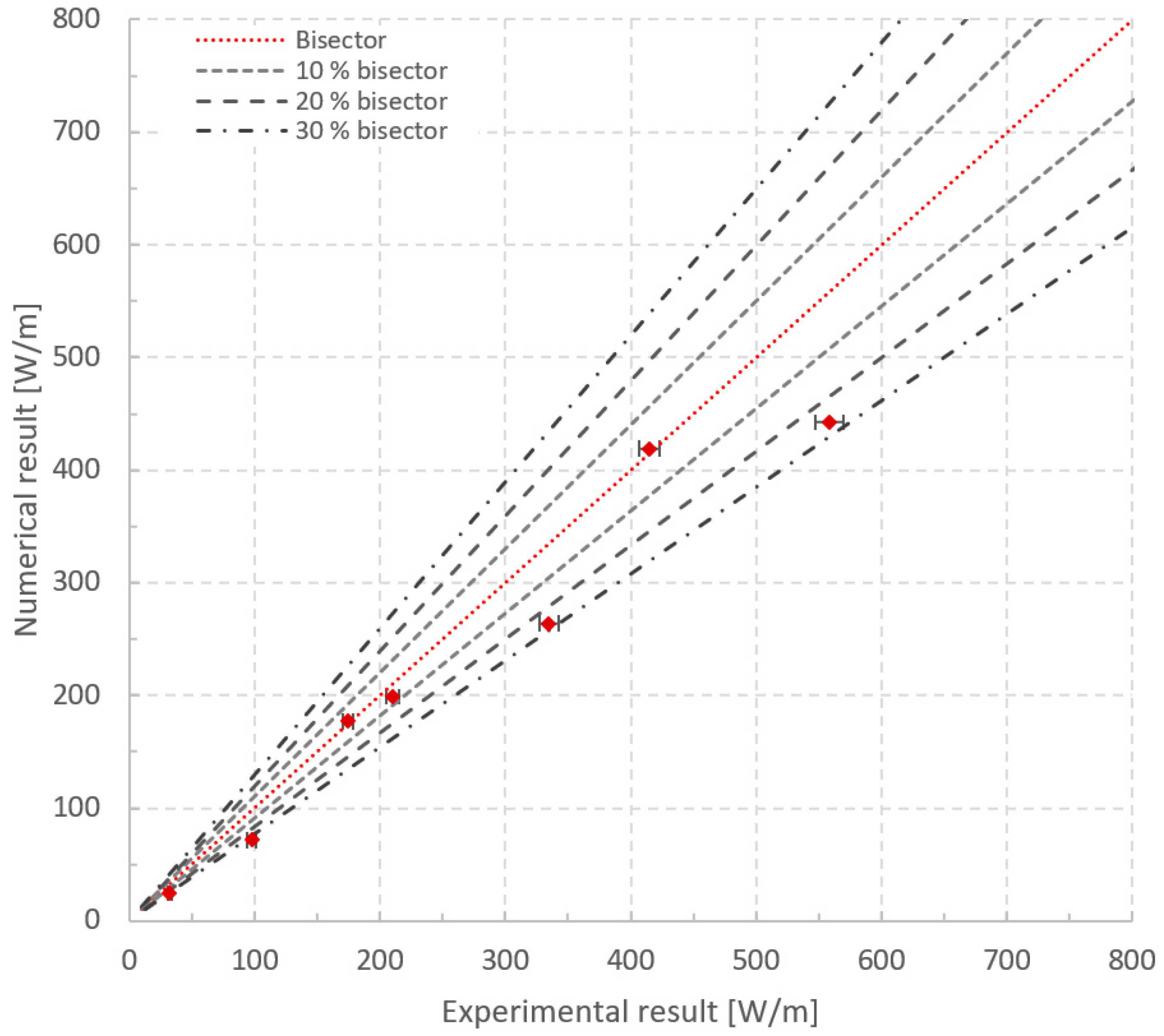

| Physical Properties of Subassemblies | Materials | |
|---|---|---|
| Density of the absorber tube | 1.4301 steel | 8000 kg/m3 |
| Thermal conductivity of the absorber tube | 15 W/m·K−1 | |
| Specific heat capacity of the absorber tube | 500 J/kg·K−1 | |
| Density of the secondary reflector | Aluminum | 2700 kg/m3 |
| Thermal conductivity of the secondary reflector | 220 W/m·K−1 | |
| Specific heat capacity of the secondary reflector | 900 J/kg·K−1 | |
| Density of the protective glass | Glass | 2500 kg/m3 |
| Thermal conductivity of the protective glass | 1.06 W/m·K−1 | |
| Specific heat capacity of the protective glass | 870 J/kg·K−1 | |
| Density of the protective enclosure | Galvanized steel | 7800 kg/m3 |
| Thermal conductivity of the protective enclosure | 50 W/m·K−1 | |
| Specific heat capacity of the protective enclosure | 450 J/kg·K−1 | |
| Optical properties of subassemblies | ||
| Emissivity of the selective coating at 300 °C | 14% | |
| Emissivity of the protective glass at 300 °C | 83% | |
| Emissivity of the protective enclosure at 300 °C | 28% |
| Date | LT/HT Protocol | Ambient Temperature (°C) | Average Wind Speeds (m/s) | Flow Rate (kg/s) | Difference between Average Inlet/Outlet Fluid Temperature and Ambient Temperature (°C) | Maximum Variation in Inlet Temperature |
|---|---|---|---|---|---|---|
| 13/01/2023 | LT | 9.3 | 10.6 | 1.4 | 22.7 | 1 |
| 27/09/2022 | LT | 13.8 | 15.6 | 1.1 | 50.3 | 9.3 |
| 14/06/2022 | LT | 19.7 | 6.6 | 1.4 | 112.3 | 17.8 |
| 06/09/2022 | LT | 13.9 | 6 | 1.5 | 123.8 | 17.6 |
| 29/09/2022 | LT | 9.2 | 13.8 | 1.1 | 144.9 | 27.6 |
| 01/07/2022 | HT | 20 | 21.6 | 1.1 | 233.7 | 7.2 |
| 07/07/2022 | HT | 18.6 | 22.1 | 1.1 | 233.9 | 4.5 |
| Solar Module | Nova-1 | LF-11 | Heliotérmica | Fresdemo | eLLO |
|---|---|---|---|---|---|
| Length of the solar module (m) | 44.8 | 4.06 | 12 | 100 | 67 |
| Collection area (m2) | 513.6 | 22.0 | 54 | 1433 | 902.2 |
| Line | Number of Missing Glasses | % of Missing Glasses |
|---|---|---|
| L1 | 53 | 17% |
| L2 | 80 | 25% |
| L3 | 66 | 21% |
| Date | LT/HT Protocol | Average Wind Speeds (m/s) | Max. Relative Deviation between Experimental and Theoretical Outlet Temperature WITHOUT Increased Heat Transfer in the Cavity | Max. Relative Difference between Experimental and Theoretical Outlet Temperature WITH Increased Heat Transfer in the Cavity |
|---|---|---|---|---|
| 14/06/2022 | LT | 6.6 | −0.8% | −0.8% |
| 06/09/2022 | LT | 6.0 | 0.7% | 0.7% |
| 27/09/2022 | LT | 15.6 | 3.8% | 3.4% |
| 29/09/2022 | LT | 13.8 | 4.0% | 3.7% |
| 13/01/2023 | LT | 10.6 | 5.1% | 4.8% |
| 01/07/2022 | HT | 20.4 | 2.1% | −0.7% |
| 07/07/2022 | HT | 21.8 | 9.8% | 8.2% |
Disclaimer/Publisher’s Note: The statements, opinions and data contained in all publications are solely those of the individual author(s) and contributor(s) and not of MDPI and/or the editor(s). MDPI and/or the editor(s) disclaim responsibility for any injury to people or property resulting from any ideas, methods, instructions or products referred to in the content. |
© 2023 by the authors. Licensee MDPI, Basel, Switzerland. This article is an open access article distributed under the terms and conditions of the Creative Commons Attribution (CC BY) license (https://creativecommons.org/licenses/by/4.0/).
Share and Cite
Montanet, E.; Rodat, S.; Falcoz, Q.; Roget, F. Experimental and Numerical Evaluation of Solar Receiver Heat Losses of a Commercial 9 MWe Linear Fresnel Power Plant. Energies 2023, 16, 7912. https://doi.org/10.3390/en16237912
Montanet E, Rodat S, Falcoz Q, Roget F. Experimental and Numerical Evaluation of Solar Receiver Heat Losses of a Commercial 9 MWe Linear Fresnel Power Plant. Energies. 2023; 16(23):7912. https://doi.org/10.3390/en16237912
Chicago/Turabian StyleMontanet, Edouard, Sylvain Rodat, Quentin Falcoz, and Fabien Roget. 2023. "Experimental and Numerical Evaluation of Solar Receiver Heat Losses of a Commercial 9 MWe Linear Fresnel Power Plant" Energies 16, no. 23: 7912. https://doi.org/10.3390/en16237912





